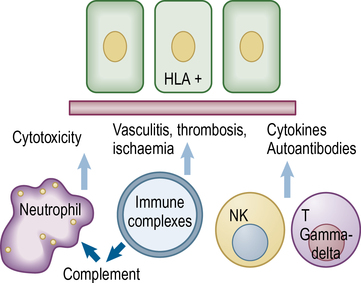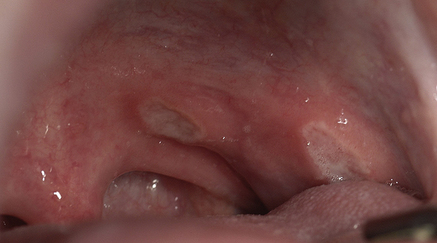Behçet syndrome
AETIOLOGY AND PATHOGENESIS
BS is an immune-related vasculitis that has not been proved to be infectious, contagious, or sexually shared (Fig. 36.1):
 There is a genetic predisposition to BS – which is strongly associated with human leukocyte antigen (HLA)-B*51 (HLA-B*5101) and HLA-A*26 (HLA-A*2601). MICA related gene A (MICA) family and MICA6 allele, a polymorphic MHC class I in linkage disequilibrium with HLA-B51, may be associated with BS. HLA-DRB1*14 is significantly increased in patients whose disease appears before age 20 years.
There is a genetic predisposition to BS – which is strongly associated with human leukocyte antigen (HLA)-B*51 (HLA-B*5101) and HLA-A*26 (HLA-A*2601). MICA related gene A (MICA) family and MICA6 allele, a polymorphic MHC class I in linkage disequilibrium with HLA-B51, may be associated with BS. HLA-DRB1*14 is significantly increased in patients whose disease appears before age 20 years.
 Associations reported with immune response genes include with:
Associations reported with immune response genes include with:
 interleukins IL-4, IL-8, IL10, IL12RB2 and IL23R
interleukins IL-4, IL-8, IL10, IL12RB2 and IL23R
 TNF alpha gene polymorphisms at locations -1031 C, -238A and the -857 T promoter
TNF alpha gene polymorphisms at locations -1031 C, -238A and the -857 T promoter
 single nucleotide polymorphisms (SNPs) near a ring finger protein (RNF) 39 and on exon 9 of tripartite motif-containing (TRIM) 39.
single nucleotide polymorphisms (SNPs) near a ring finger protein (RNF) 39 and on exon 9 of tripartite motif-containing (TRIM) 39.
 An antigen responsible for BS has not been reliably identified though a viral aetiology (possibly herpes simplex virus) has been proposed, and a delayed-type hypersensitivity reaction to the oral bacterium Streptococcus sanguis has been implicated. There may be an HLA-independent antibacterial host response toward Th 1 immunity mediated by IL-12. The aetiological factors may have a common denominator in heat shock proteins (HSP), particularly 65 kDa microbial HSP, which shows significant homology with the human 60 kDa mitochondrial HSP. Indeed, the uncommon serotypes of oral Streptococcus sanguis found in BS cross-react with the 65 kDa HSP (Hsp-60/65), which also shares antigenicity with an oral mucosal antigen. Although Hsp-60/65 has homologies with the respective T cell epitope, it stimulates peripheral blood mononuclear cells from BS patients. On the other hand, some peptides of Hsp-60/65 reduce IL-8 and IL-12 production from BS patients mononuclear cells during active disease. In BS there are high levels of salivary S. mutans colonization associated with oral ulcers and in male patients with a severe disease course and also related to very low levels of serum mannose-binding lectin (MBL). The relationship between increased S. mutans and MBL deficiency with active disease may indicate streptococcal hypersensitivity and an impaired innate immune response in BS patients which may predispose to oral infections and a severe disease course. Specific positive signals against human and against streptococcal α-enolase are also common in BS. An HLA-B51 restricted CD8 T cell response is correlated with the target tissues expressing MICA*009 by stress in BS patients with HLA-B51 as the intrinsic factor. Bes-1 gene encodes partial S. sanguis genome which is highly homologous with retinal protein Brn3b, and Hsp-60. Hsp-65/60 also has high homologies with the respective T cell epitope of BS patients. Although Hsp-65/60 and peptides of Bes-1 gene were found to stimulate mononuclear from BS patients in the production of pro-inflammatory Th1 type cytokines, some homologous peptides of Hsp-65 with T cell epitopes were found to reduce IL-8, IL-12 and TNF-alpha production. Selenium binding protein may be a target antigen in Behçet uveitis, while anti-Saccharomyces cerevisiae antibodies may be implicated in intestinal BS.
An antigen responsible for BS has not been reliably identified though a viral aetiology (possibly herpes simplex virus) has been proposed, and a delayed-type hypersensitivity reaction to the oral bacterium Streptococcus sanguis has been implicated. There may be an HLA-independent antibacterial host response toward Th 1 immunity mediated by IL-12. The aetiological factors may have a common denominator in heat shock proteins (HSP), particularly 65 kDa microbial HSP, which shows significant homology with the human 60 kDa mitochondrial HSP. Indeed, the uncommon serotypes of oral Streptococcus sanguis found in BS cross-react with the 65 kDa HSP (Hsp-60/65), which also shares antigenicity with an oral mucosal antigen. Although Hsp-60/65 has homologies with the respective T cell epitope, it stimulates peripheral blood mononuclear cells from BS patients. On the other hand, some peptides of Hsp-60/65 reduce IL-8 and IL-12 production from BS patients mononuclear cells during active disease. In BS there are high levels of salivary S. mutans colonization associated with oral ulcers and in male patients with a severe disease course and also related to very low levels of serum mannose-binding lectin (MBL). The relationship between increased S. mutans and MBL deficiency with active disease may indicate streptococcal hypersensitivity and an impaired innate immune response in BS patients which may predispose to oral infections and a severe disease course. Specific positive signals against human and against streptococcal α-enolase are also common in BS. An HLA-B51 restricted CD8 T cell response is correlated with the target tissues expressing MICA*009 by stress in BS patients with HLA-B51 as the intrinsic factor. Bes-1 gene encodes partial S. sanguis genome which is highly homologous with retinal protein Brn3b, and Hsp-60. Hsp-65/60 also has high homologies with the respective T cell epitope of BS patients. Although Hsp-65/60 and peptides of Bes-1 gene were found to stimulate mononuclear from BS patients in the production of pro-inflammatory Th1 type cytokines, some homologous peptides of Hsp-65 with T cell epitopes were found to reduce IL-8, IL-12 and TNF-alpha production. Selenium binding protein may be a target antigen in Behçet uveitis, while anti-Saccharomyces cerevisiae antibodies may be implicated in intestinal BS.
 Many immunological findings in BS are similar to those seen in RAS (Ch. 34), with various T lymphocyte abnormalities and increased polymorphonuclear leukocyte motility. There is increased T cell (Th-1) activity, cells infiltrating into lesions expressing interferon (IFN)-gamma. Proinflammatory cytokines IL-12, IL-18 and tumour necrosis factor alpha (TNF-alpha) are increased and some, such as IL-12, are potent inducers of the Th-1 immune reaction. IL-2 and IL-6 cytokines and T regulatory cells (Treg cell) also play a major role, particularly CD4(+) CD25(bright) cells. Th17 cells can contribute to the development of the disease with their proinflammatory cytokine IL-17. IL-21 may promote Th17 effectors and suppress Treg cells. Th2 may also play a role. Interleukin-12B heterozygosity is associated with BS susceptibility and plays an important role in mediating Th1 antistreptococcal immune response.
Many immunological findings in BS are similar to those seen in RAS (Ch. 34), with various T lymphocyte abnormalities and increased polymorphonuclear leukocyte motility. There is increased T cell (Th-1) activity, cells infiltrating into lesions expressing interferon (IFN)-gamma. Proinflammatory cytokines IL-12, IL-18 and tumour necrosis factor alpha (TNF-alpha) are increased and some, such as IL-12, are potent inducers of the Th-1 immune reaction. IL-2 and IL-6 cytokines and T regulatory cells (Treg cell) also play a major role, particularly CD4(+) CD25(bright) cells. Th17 cells can contribute to the development of the disease with their proinflammatory cytokine IL-17. IL-21 may promote Th17 effectors and suppress Treg cells. Th2 may also play a role. Interleukin-12B heterozygosity is associated with BS susceptibility and plays an important role in mediating Th1 antistreptococcal immune response.
 Circulating autoantibodies against a number of components, including intermediate filaments found in mucous membranes, cardiolipin and neutrophil cytoplasm, are present. There are raised levels of acute phase proteins and circulating immune complexes and changed levels of complement. There is immunoglobulin and complement deposition within and around blood vessel walls.
Circulating autoantibodies against a number of components, including intermediate filaments found in mucous membranes, cardiolipin and neutrophil cytoplasm, are present. There are raised levels of acute phase proteins and circulating immune complexes and changed levels of complement. There is immunoglobulin and complement deposition within and around blood vessel walls.
 Vasculitis: usually leukocytoclastic vasculitis underlies many of the clinical features (erythema nodosum, arthralgia, uveitis) as in established immune complex diseases/vasculitis. Immunocytes (mostly CD4 cells), B cells, and neutrophils infiltrate perivascularly. Endothelial dysfunction in vasculitis may be detected by assay of a novel autoantigen Sip1 C-ter.
Vasculitis: usually leukocytoclastic vasculitis underlies many of the clinical features (erythema nodosum, arthralgia, uveitis) as in established immune complex diseases/vasculitis. Immunocytes (mostly CD4 cells), B cells, and neutrophils infiltrate perivascularly. Endothelial dysfunction in vasculitis may be detected by assay of a novel autoantigen Sip1 C-ter.
 Hypercoagulability is also a feature: prostanoid synthesis in endothelial cells or vessel walls is impaired, whereas von Willebrand factor, endothelin-1,2, thromboxane and thrombomodulin are increased and factor V Leiden and prothrombin mutations are associated with thromboses in BS.
Hypercoagulability is also a feature: prostanoid synthesis in endothelial cells or vessel walls is impaired, whereas von Willebrand factor, endothelin-1,2, thromboxane and thrombomodulin are increased and factor V Leiden and prothrombin mutations are associated with thromboses in BS.
CLINICAL FEATURES
BS is a chronic multisystem and sometimes life-threatening vasculitis, characterized mainly by:
 Oral aphthous-like ulceration: in 90–100% of cases (Fig. 36.2) is the most common and usually the initial manifestation of BS. Oral ulcers precede the diagnosis by 7.5 ± 10 years. However, only few patients with aphthous-like ulceration progress to BS and it is not possible to determine in which patients or when the transition may occur. Recent HLA and immunological findings may eventually help in this respect.
Oral aphthous-like ulceration: in 90–100% of cases (Fig. 36.2) is the most common and usually the initial manifestation of BS. Oral ulcers precede the diagnosis by 7.5 ± 10 years. However, only few patients with aphthous-like ulceration progress to BS and it is not possible to determine in which patients or when the transition may occur. Recent HLA and immunological findings may eventually help in this respect.
 Recurrent painful genital ulcers that tend to heal with scars: in 64–88% of cases. Genital ulcers are especially common in females with BS, resemble RAS and precede the diagnosis by 1–2 years.
Recurrent painful genital ulcers that tend to heal with scars: in 64–88% of cases. Genital ulcers are especially common in females with BS, resemble RAS and precede the diagnosis by 1–2 years.
 Ocular lesions: precede the diagnosis by 1–2 years. The most common ocular manifestation is relapsing iridocyclitis, but uveitis with conjunctivitis (early) and hypopyon (late), retinal vasculitis (posterior uveitis), iridocyclitis and optic atrophy can arise.
Ocular lesions: precede the diagnosis by 1–2 years. The most common ocular manifestation is relapsing iridocyclitis, but uveitis with conjunctivitis (early) and hypopyon (late), retinal vasculitis (posterior uveitis), iridocyclitis and optic atrophy can arise.
 CNS lesions are predominantly subtentorial (affecting cerebellum, brainstem and spinal cord), with meningoencephalitis, cerebral infarction, psychosis, cranial nerve palsies, and hemi- an/>
CNS lesions are predominantly subtentorial (affecting cerebellum, brainstem and spinal cord), with meningoencephalitis, cerebral infarction, psychosis, cranial nerve palsies, and hemi- an/>
Stay updated, free dental videos. Join our Telegram channel

VIDEdental - Online dental courses








